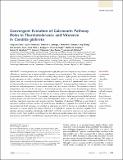Convergent Evolution of Calcineurin Pathway Roles in Thermotolerance and Virulence in Candida glabrata
Author(s)
Regev, Aviv; Chen, Ying-Lien; Konieczka, Jay; Springer, Deborah J.; Bowen, Samantha E.; Zhang, Jing; Silao, Fitz Gerald S.; Bungay, Alice Alma C.; Bigol, Ursela G.; Nicolas, Marilou G.; Abraham, Soman N.; Thompson, Dawn A.; Heitman, Joseph; ... Show more Show less
DownloadRegev_Convergent Evolution.pdf (3.044Mb)
PUBLISHER_CC
Publisher with Creative Commons License
Creative Commons Attribution
Terms of use
Metadata
Show full item recordAbstract
Candida glabrata is an emerging human fungal pathogen that is frequently drug tolerant, resulting in difficulties in treatment and a higher mortality in immunocompromised patients. The calcium-activated protein phosphatase calcineurin plays critical roles in controlling drug tolerance, hyphal growth, and virulence in diverse fungal pathogens via distinct mechanisms involving survival in serum or growth at host temperature (37° and higher). Here, we comprehensively studied the calcineurin signaling cascade in C. glabrata and found novel and uncharacterized functions of calcineurin and its downstream target Crz1 in governing thermotolerance, intracellular architecture, and pathogenesis in murine ocular, urinary tract, and systemic infections. This represents a second independent origin of a role for calcineurin in thermotolerant growth of a major human fungal pathogen, distinct from that which arose independently in Cryptococcus neoformans. Calcineurin also promotes survival of C. glabrata in serum via mechanisms distinct from C. albicans and thereby enables establishment of tissue colonization in a murine systemic infection model. To understand calcineurin signaling in detail, we performed global transcript profiling analysis and identified calcineurin- and Crz1-dependent genes in C. glabrata involved in cell wall biosynthesis, heat shock responses, and calcineurin function. Regulators of calcineurin (RCN) are a novel family of calcineurin modifiers, and two members of this family were identified in C. glabrata: Rcn1 and Rcn2. Our studies demonstrate that Rcn2 expression is controlled by calcineurin and Crz1 to function as a feedback inhibitor of calcineurin in a circuit required for calcium tolerance in C. glabrata. In contrast, the calcineurin regulator Rcn1 activates calcineurin signaling. Interestingly, neither Rcn1 nor Rcn2 is required for virulence in a murine systemic infection model. Taken together, our findings show that calcineurin signaling plays critical roles in thermotolerance and virulence, and that Rcn1 and Rcn2 have opposing functions in controlling calcineurin signaling in C. glabrata.
Date issued
2012-06Department
Massachusetts Institute of Technology. Department of BiologyJournal
G3: Genes-Genomes-Genetics
Publisher
Genetics Society of America, The
Citation
Chen, Y.-L., J. H. Konieczka, D. J. Springer, S. E. Bowen, J. Zhang, F. G. S. Silao, A. A. C. Bungay, et al. “Convergent Evolution of Calcineurin Pathway Roles in Thermotolerance and Virulence in Candida glabrata.” G3: Genes|Genomes|Genetics 2, no. 6 (June 1, 2012): 675-691.
Version: Final published version
ISSN
2160-1836